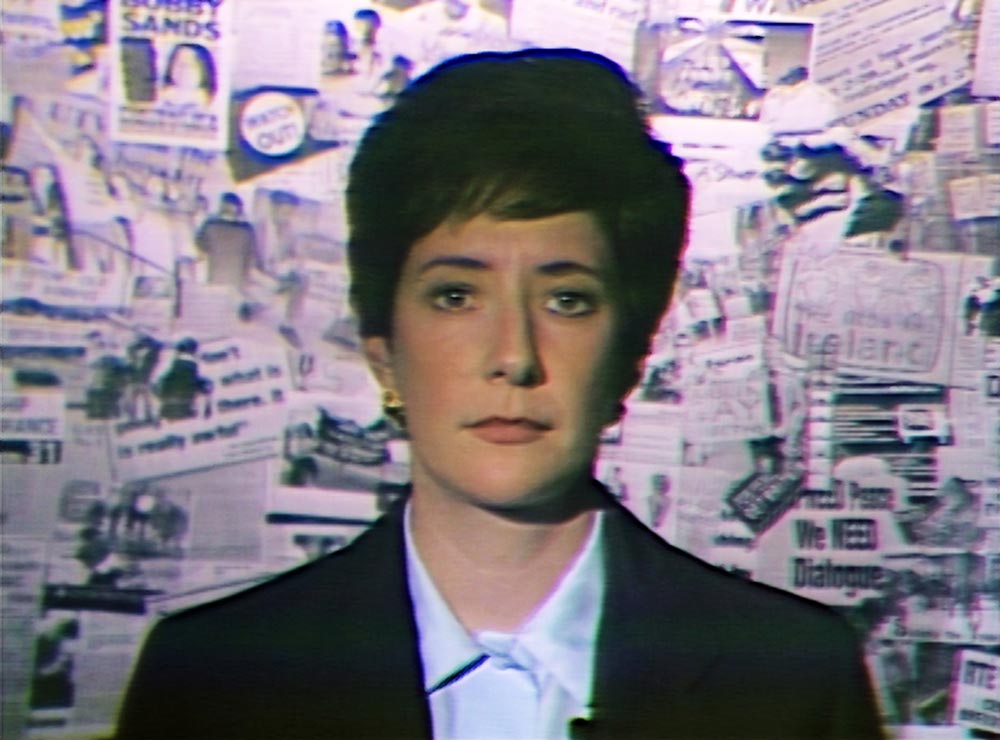
Darkness and static opens Frank Sweeney’s Few Can See (2023), a film that tries to fill the gaps in Ireland’s public memory. After an introductory montage, a 1980s news reporter informs us that a broadcast strike has broken out across Ireland and the United Kingdom in response to a “culture of self-censorship” around the violence in Northern Ireland. She goes on to say that instead of regular programming, her and her striking colleagues at RTÉ, Ireland’s public broadcaster, will examine how this censorship came to reign and the stories ignored because of it.
Few Can See focuses on the broadcast censorship of activists and social movements accused of affiliation with the Provisional Irish Republican Army (IRA) that waged an insurgency against British control of Northern Ireland from 1969 until a ceasefire in 1997. The governments of Ireland and the UK, worried that the IRA was using their TV and radio stations to amplify its message, ordered broadcasters not to promote anyone associated with the movement or any other outlawed organizations. This included the IRA’s above-ground political wing, Sein Féin, as well as a range of other associated social movements. In the UK, the ban specifically prohibited giving voice to outlawed groups, which broadcasters got around by re-dubbing spokespeople with actors—as if the mere sound of their voices could provoke political violence. Journalists launched several protests and broadcast strikes against this censorship, but the wildcat news program in Few Can See is not real. It is instead, a meticulously crafted counterfactual of what could have been, shot in 4:3 aspect ratio on 1980s tube cameras and intercut with archival footage. (Sweeney even transmitted the footage across the length of his studio to recreate the beautiful auras and distortions of UHF broadcasting.)
The film is built around interviews with activists—reenacted by actors from oral history accounts Sweeney recorded before making the film. In one interview, an activist talks about the work of Concerned Parents Against Drugs and accusations that the group is a front for Sein Féin. Another activist describes organizing with the Cork Gay Collective to provide support for IRA prisoners on hunger strike and expanding that into a larger movement for gay liberation and AIDS activism. In a third interview, a labor activist describes how his association with a political prisoner campaign caused RTÉ to censor coverage of a strike at the bakery where he worked. These examples show how the question of Northern Ireland cut across a range of social and political issues, and how hard it is to untangle questions of social progress from political freedom. Although great effort went into making the film feel authentically of its time, it’s hard not to think of the apparent wave of censorship plaguing institutions and media rooms in the wake of October 7 and Israel’s brutal invasion of Gaza—the 92 Street Y canceling a book talk by Viet Thanh Nguyen, for example, or MSNBC sidelining anchor Mehdi Hasan. Like Irish nationalism, the question of Palestinian freedom runs like a current through most left-leaning American political movements. As institutions rush to deplatform perceived critics of Israel, we can imagine what other voices might fall into the lacuna of public record.
Few Can See screens this afternoon, August 11, at Anthology Film Archives as part of the series “Verbatim.”


